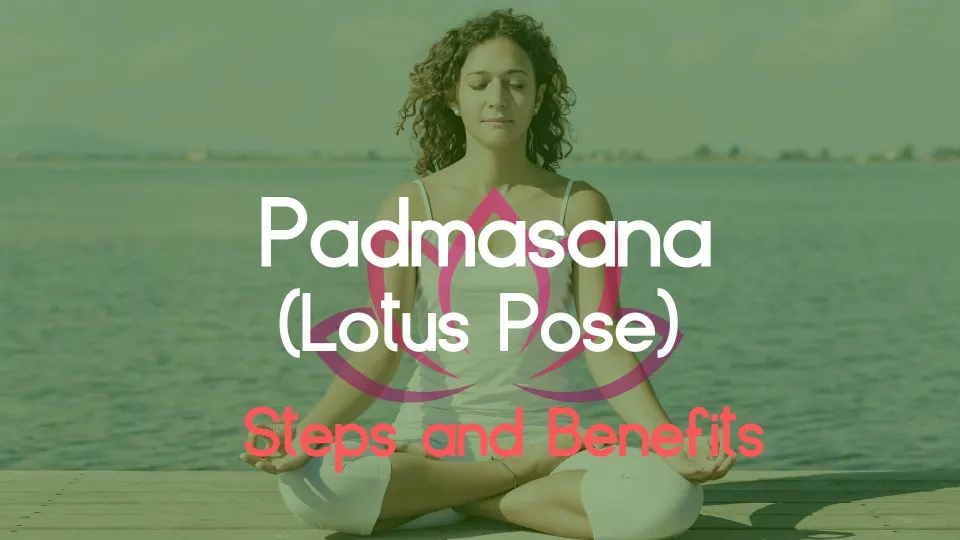Padmasana or Lotus Pose
Padmasana or commonly known as Lotus Pose is a most popular and ancient sitting posture used commonly for meditation. It is an ultimate yoga posture that provides physical as well as emotional stability to the body. It is also believed that continuous practise of this asana destructs all the diseases.
In Hindu culture, the Lotus flower symbolizes growth, prosperity, purity and eternity. Lotus grows in mud but as time passes, it blossoms into a very beautiful flower. Like ways, continuous practice of this posture helps the yogi to connect their body with mind and soul and helps to move towards enlightenment.
The said posture is also linked with various religions like Buddhism, Jainism etc. as Lord Buddha or Jain Tirthankaras used to sit in this posture to meditate
What is Padmasana?
The word Padmasana consists of two Sanskrit words, Padma and Asana. The Padma means Lotus and Asana means “posture”. It is a posture that is performed by placing each foot on the opposite thigh. It is called a lotus pose due to the lotus-like posture made during its practice.
This posture is also known as Kamalasana
Benefits of Padmasana
This posture has both physical, mental and spiritual benefits. Some of the major benefits are as follows:
Physical benefits
- Improves the digestion system of the body and helps to reduce digestive issues such as constipation
- It helps to open the hip joints and simulates the lower part of the body including the thighs and ankles
- It strengthens the ankle and knee joints.
- Continuous practise of the asana also helps in reducing the fat accumulated in the thighs and hips
- Reduces muscular tension and brings blood pressure under control
- It also helps to strengthen the spinal cord
- Helps to fight insomnia
- Strengthens the respiratory system due to slow practice of inhaling and exhaling during this posture.
- For women, it helps to regulate their periods and also reduces the menstrual cramps
Mental Benefits
- It acts as a foundation for starting meditative practices
- It helps to increase our focus and the concentration of power
- It relaxes our mind and body and reduces the stress level
- It helps to awaken the consciousness
Preparatory poses for Padmasana
There are certain poses that can be used to prepare the body to do Padmasana. The poses are as follows:
- Janushirasasana
- Baddha Konasana or Butterfly pose
- Gomukhasana or Cow face pose
- Ardha Matsyendrasana or Half Fish Pose
Precautions to be taken while doing Padmasana
- People who are suffering from any knee, calf or ankle injury should not do this pose.
- This pose should be done on an empty stomach as it directly stimulates the stomach muscles or 4-5 hours after eating
- Stretching of knees, ankle joints and calf muscles should be done before getting into Padmasana pose otherwise it may hurt the knees or ankles
- Try to focus on the breathing while performing this pose to get the best benefits
How long can it be done?
Starting practice can be done for 5 minutes and can be later increased to 15-20 minutes as per the capacity of the individual
Steps to perform Padmasana
- Sit on the floor in the Dandasana position with your legs stretched outwards. Bend your right knee and place it on your left thigh.
- Similarly, bend your left knee and place it on your right thigh.
- Ensure that your both knees touch the ground, Further, the sole of the feet should be facing upwards.
- Your Spinal cord should be straight and erect.
- Put both the palms on the knee in Gyan Mudra (thumb touching the tip of the index finger and other three fingers straight facing up.
- Inhale and exhale slowly in the same position for best results.
- It is also said that putting the right leg first on the left thigh and then bringing the left leg on the top stimulates the liver and spleen
How to start for beginners
The beginners, who do have enough flexibility and strength in the lower body, can start by performing the preparatory poses mentioned above and through Ardha Padmasana or half lotus pose. They can first start by putting only the right leg on the left thighs and can hold for some time. Later. Practice can be done with another side, i.e. putting the left leg on the right thigh. The time to hold the posture can be increased with gradual practice
Variations of Padmasana
- ArdhaPadmasana – As mentioned above, in this pose, bend one leg and put on the opposite leg’s thigh and the other leg bend and rest on the ground. It is a comparatively simple pose.
- Baddha Padmasana – In this pose, sit in the lotus pose first and try to hold the left toe from the right hand through the back and hold the right toe from the left hand through the back. If the yogi is not able to hold hands, he can take the help of straps initially to hold the toe
- Uthith Padmasana – In this pose the practitioner sits in the pose. Then place both hands on the ground and lift the body and balance it on the palms. It requires strength in the hands and in the core.
- Kukkutasana – The yogi sits in the lotus pose, and inserts the arms between the thighs and calves. Place the palms on the floor and lifts the body
- Variations of several other asanas such as Sirsasana, Sarvangasana, Simhasana (lion pose), Matsyasana, Gorakshasana, Halasana, Bakasana, Mayurasana etc. can be performed with legs in lotus posture.
Conclusion
In conclusion, the Lotus posture is one of the most ancient and powerful asanas, which not only provide physical benefits but has mental and spiritual benefits. The goal of yoga is to connect the body, and mind with the soul which can be achieved with regular practise of this asana.
In today’s life, where we are running continuously at a fast pace and in the kind of environment we live in, the Lotus pose is definitely a must-go pose to achieve a healthy and well-being life.
Caution:
While Padmasana has various benefits, it is advisable to do it under the instructions of the trainer or yoga guru, otherwise, it may lead to various injuries or pains in the body.
HAPPY DOING YOGA!!


Amazingly enriching blog! Keep up the good work 👏!
Very interesting article. Keep doing yoga.
Beautifully described…it shows how much you enjoy Yoga…
Great job..Keep it up 👏👏👏
Thanks 😊 please share it in your circle also, so that they can also get benefitted 😊🙂
Superb; got to know a lot of things about padmasana.
Keep practicing Yoga 😃
Thanks 😊